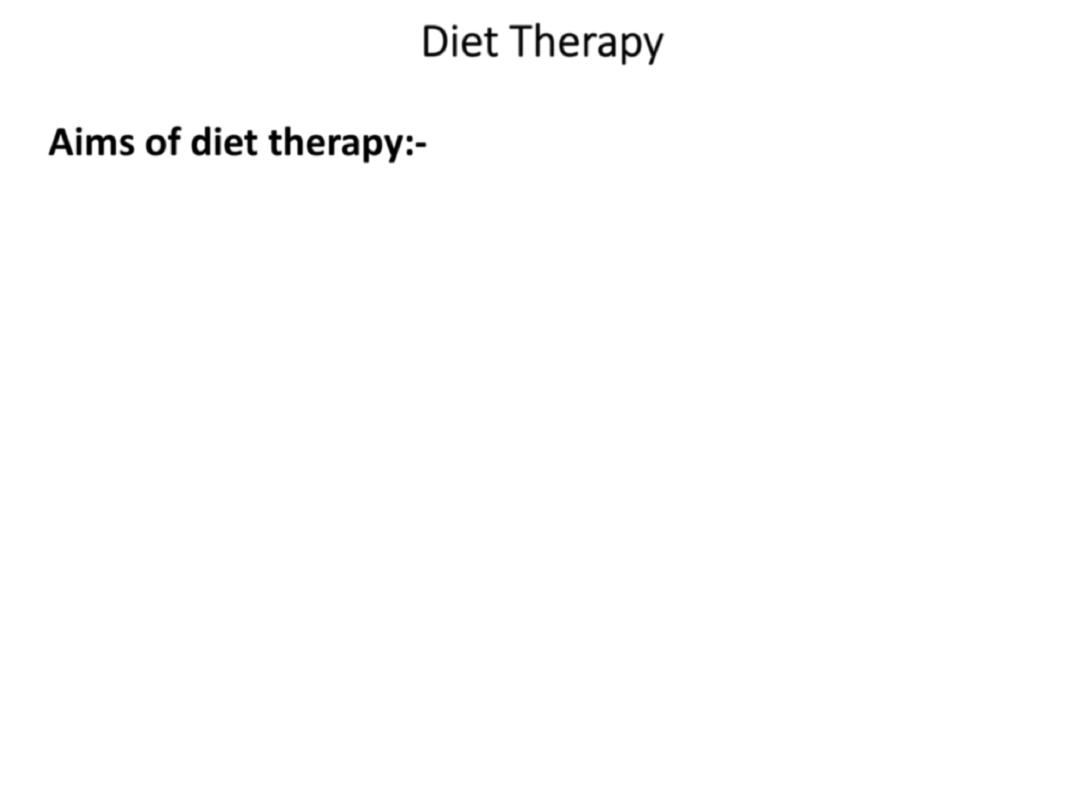
Diet Therapy
Aims of diet therapy:-
1.To prevent or treat malnutrition .
2.To control diet - related manifestations of disease .
3.To delay progression of chronic disease .
4.To provide support for other medical or surgical
treatment .
5.To
play
rehabilitative
and
palliative
role
e.g.
maintaining or enhancing quality of life in terminally ill
patients .
6.Dietary advice is useful for health promotion , disease
prevention , nutritional support and rehabilitation.
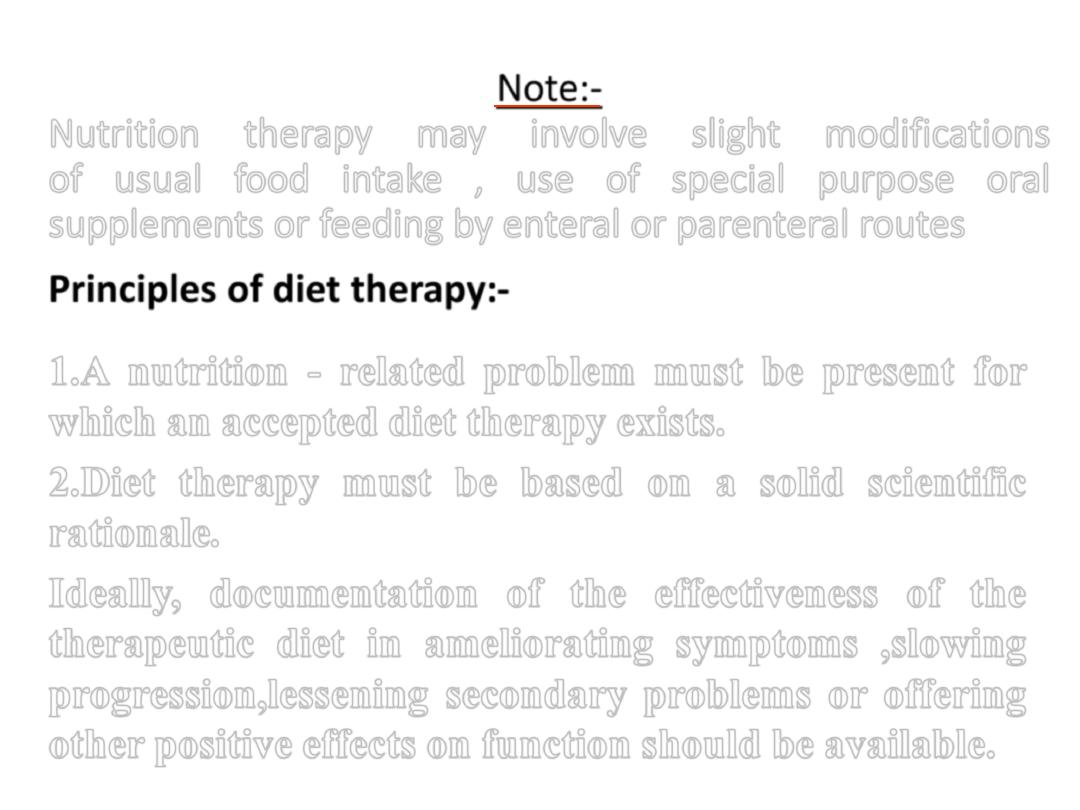
Note:-
Nutrition therapy may involve slight modifications
of usual food intake , use of special purpose oral
supplements or feeding by enteral or parenteral routes.
Principles of diet therapy:-
1.A nutrition - related problem must be present for
which an accepted diet therapy exists.
2.Diet therapy must be based on a solid scientific
rationale.
Ideally, documentation of the effectiveness of the
therapeutic diet in ameliorating symptoms ,slowing
progression,lessening secondary problems or offering
other positive effects on function should be available.

3.Patient must be able and willing to eat and must have a
functional gastrointestinal tract.
Note :-
Little effort is required for a patient to consume a diet in
the hospital since appropriate meals are served and no
other food choice may be available ,but a great deal of
motivation is needed to prepare and eat therapeutic
diets after discharge.
4.Patient must adhere to the diet.
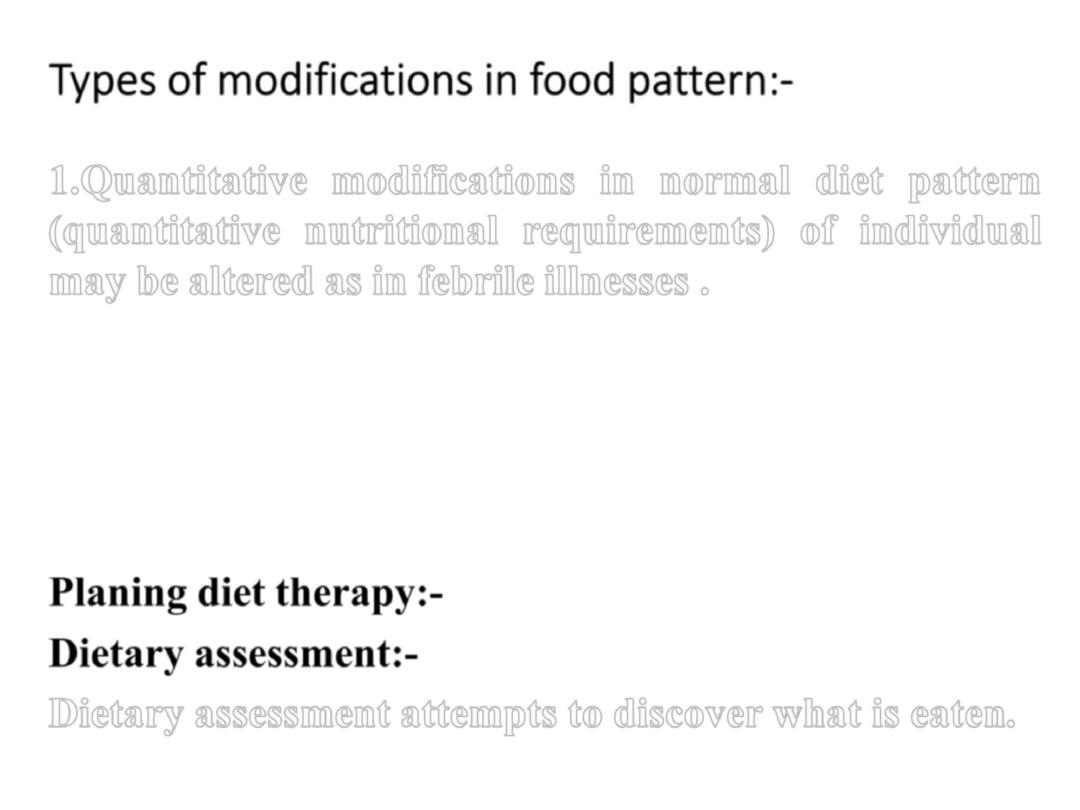
Types of modifications in food pattern:-
2.Qualitative modifications or changes might required
e.g. in congestive heart failure , sodium restricted diet.
3.Changes in diet consistency e.g. liquid , soft & bland
diet in certain GIT disorders.
1.Quantitative modifications in normal diet pattern
(quantitative nutritional requirements) of individual
may be altered as in febrile illnesses .
Planing diet therapy:-
Dietary assessment:-
Dietary assessment attempts to discover what is eaten.

It requires cataloging what the individual usually eats and
the nutritional quality and adequacy of that pattern.
It helps in determining nutritional status ,
establishing or defining differential diagnosis and
furnishing the background information on food intake
and preferences that are needed for implementing diet
therapy.
Nutritional
status
assessment
measures
the
interaction
of
diet
,
disease
and
nutritional
requirements by integrating information on food
intake and clinical , biochemical and anthropometric
measurements.
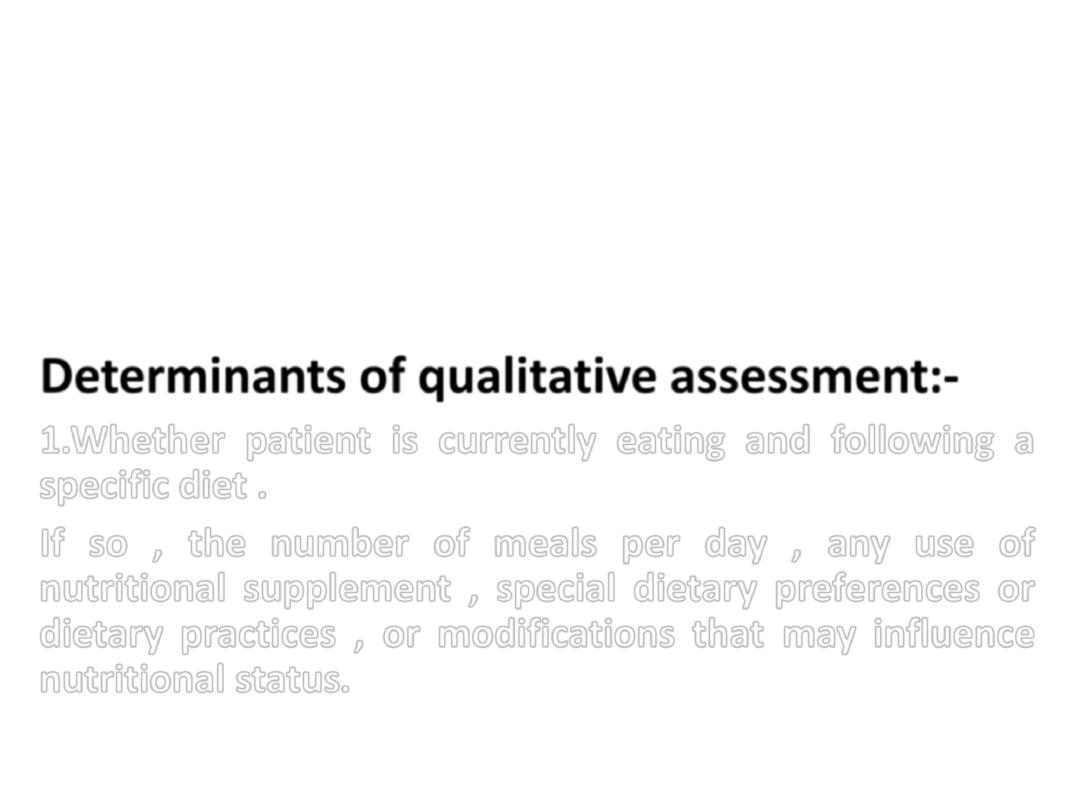
Both dietary assessment and nutritional status
assessment are needed to identify nutrition-related
problems and plan therapeutic diets.
Determinants of qualitative assessment:-
1.Whether patient is currently eating and following a
specific diet .
If so , the number of meals per day , any use of
nutritional supplement , special dietary preferences or
dietary practices , or modifications that may influence
nutritional status.
Dietary assessment can be performed at qualitative
or quantitative levels.

2.Whether there has been recent weight loss or gain.
3.The physical state including chewing problems ,
dysphagia , diarrhea , ability to shop and cook & feed
oneself.
4.Social circumstances that may influence intake e.g.
economic resources , social isolation and social support
systems.
If qualitative assessment suggests that nutritional
problems may exits , more quantitative approaches
may be in order.
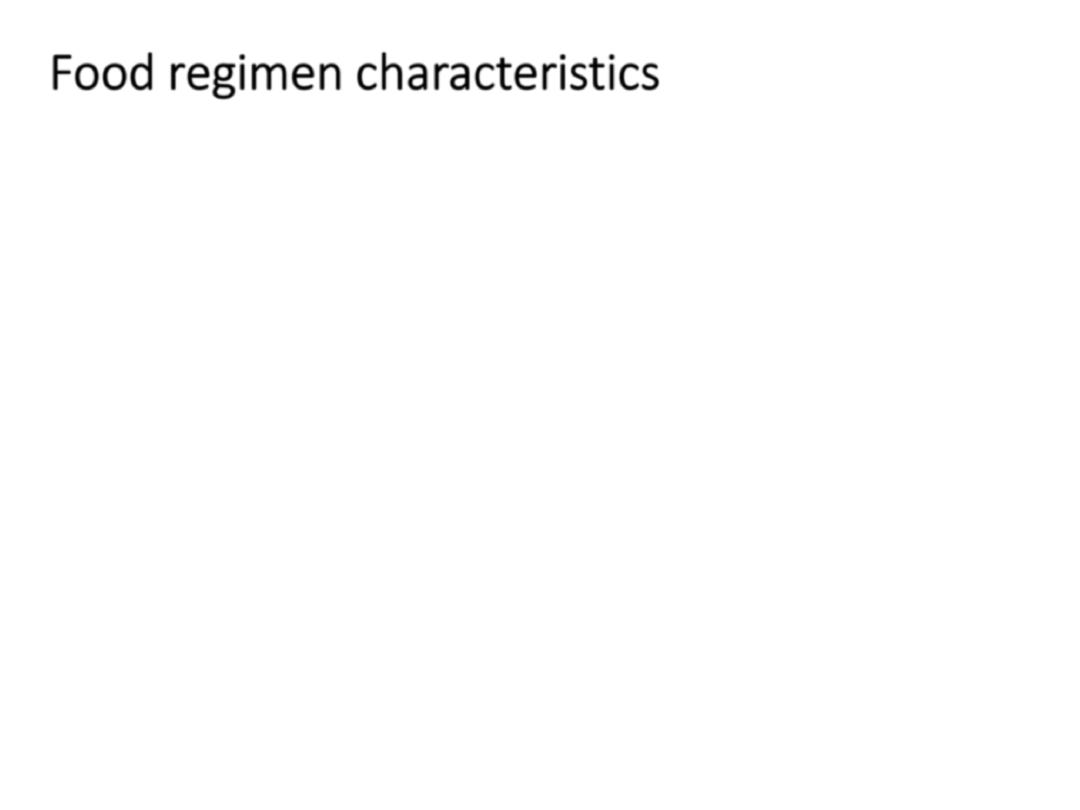
Food regimen characteristics
1.Diet should provide all essential nutrients.
2.Food regimen should be patterned as much as
possible after normal diet.
3.Diet should be flexible (according to patients habit,
preferences , economic status ,and religious rules).
4.Diet should be adapted according to patient work and
degree of exercise.
5.Food must be agreed with patient.
6.Diet should emphasize natural ,commonly used foods
that are readily available and easily prepared at home.

7.Prescribed food regimen must accompanied by
clear simple explanation of purpose for both
patient and family.
8.Except for cases adhered to for life maintenance
diet, patients should be taken off special diets as
soon as possible.
9.Diet regimen should be absolutely justifiable and
defensible for patient & family.
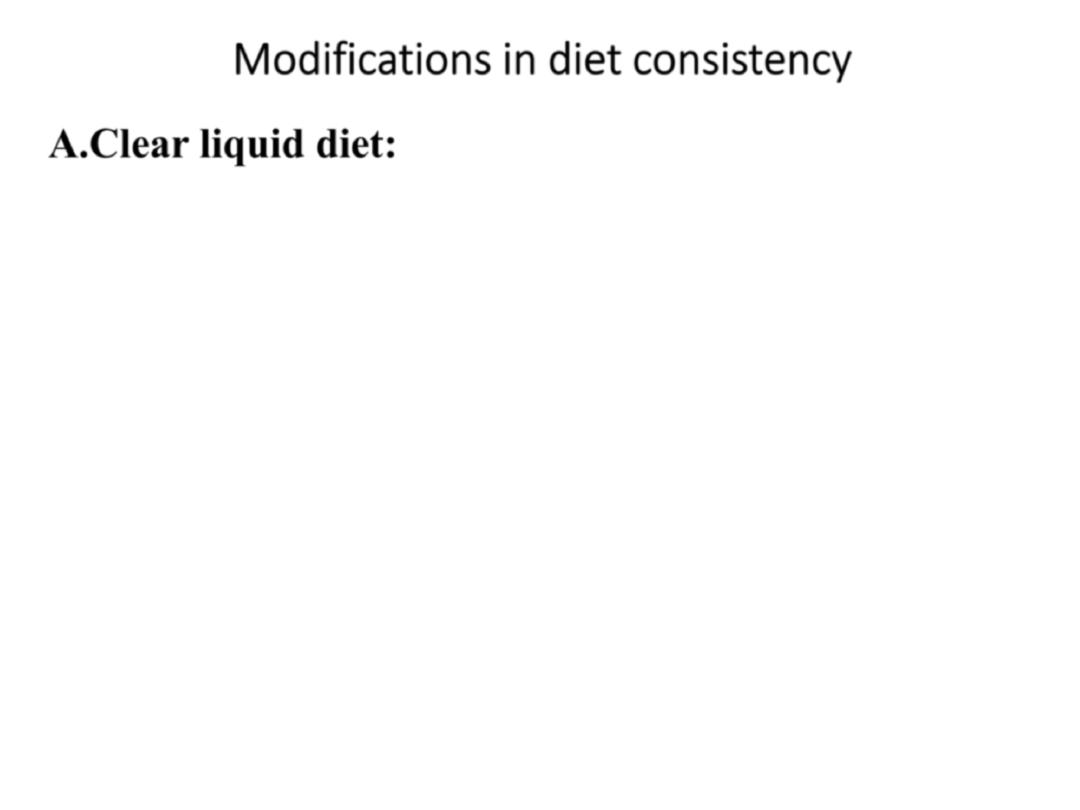
Modifications in diet consistency
Usually a short term diet.
Its purpose is to supply fluid and some energy in a
form that requires minimal digestion after surgery ,
trauma , or in acute illness.
It is used as initial feeding after surgery or intravenous
feeding to relieve thirst and hydrate ,while minimizing
the need to chew and GIT stimulation.
Nutritionally , it is inadequate diet thus if to continue
beyond 3-5 days , nutritional support is necessary.
It produces few or no feces.
A.Clear liquid diet:
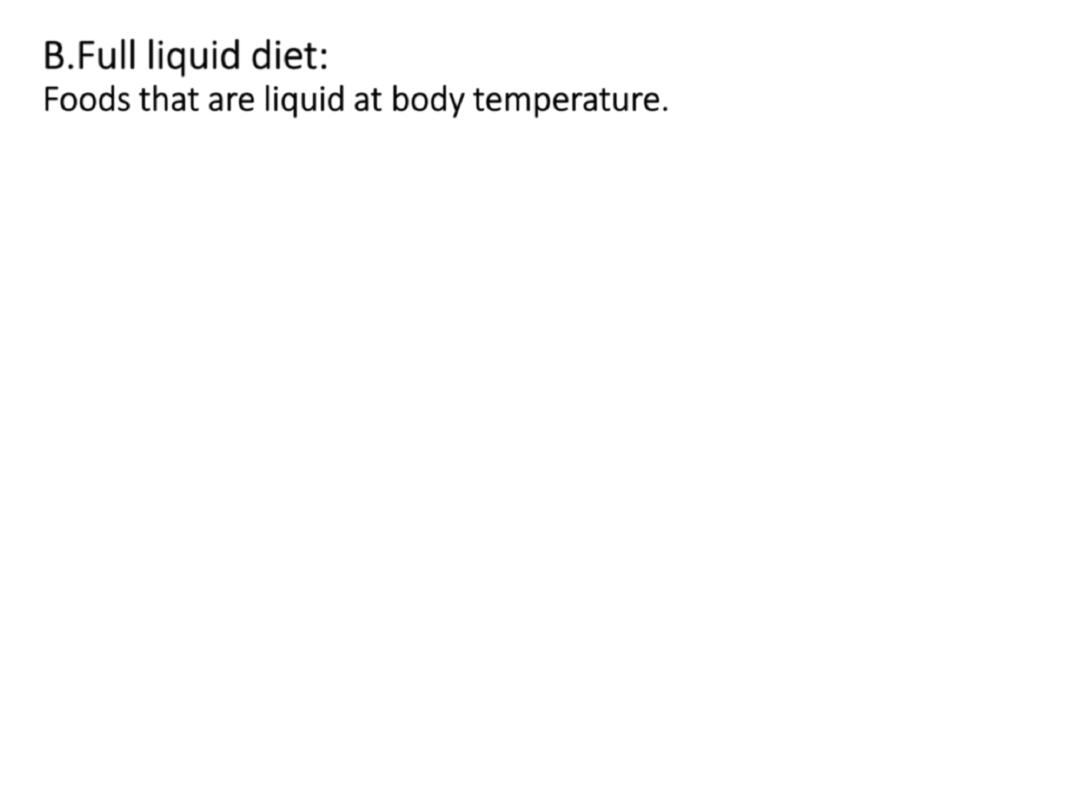
B.Full liquid diet:
Foods that are liquid at body temperature.
Its purpose is to supply fluid & meet energy & other
nutrients need .
Usually higher in calories than clear liquid diet.
It is used as transition between clear liquid and solid
foods , after surgery and in acute illnesses ; in esophageal
or stomach disorders with strictures or anatomical
irregularity ; and for inability to chew or swallow solid
foods.
Nutritionally , it may be inadequate in niacin , folacin
and iron. Nutritional adequacy may be improved by using
high-protein , high-calorie supplement or the addition of
multivitamin supplement.
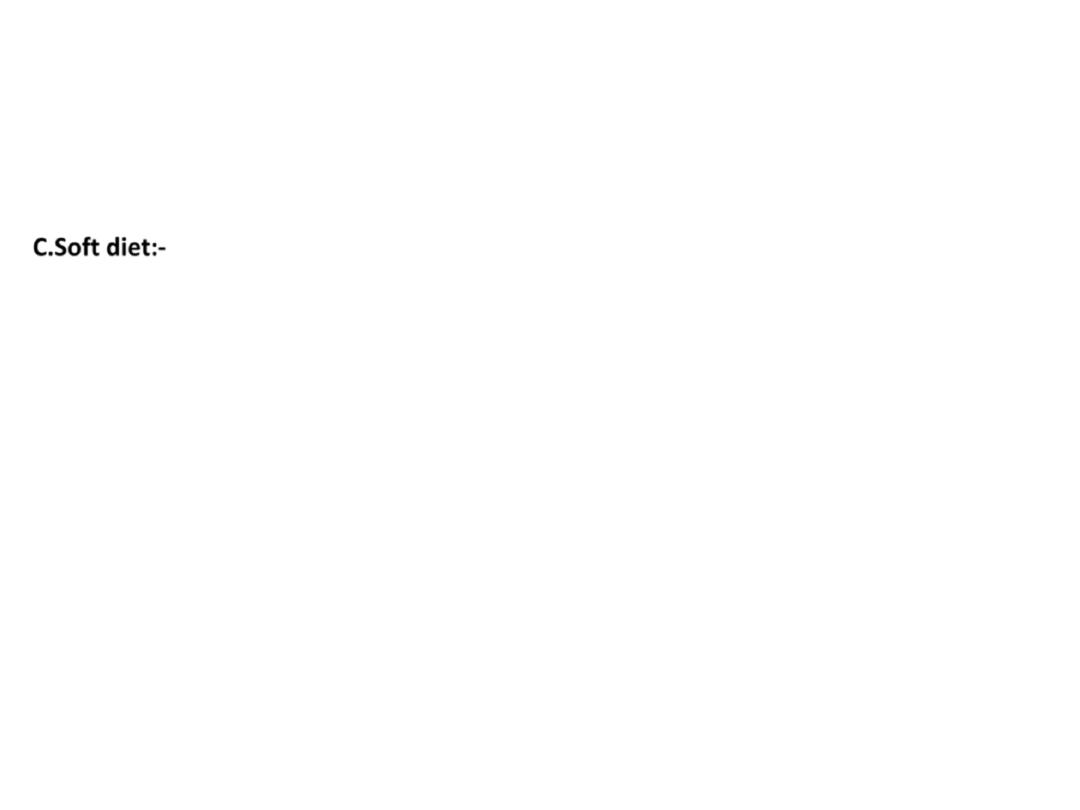
It is more complete than clear liquid diet . It is beneficial as
a transitional feeding for weak patients who cannot
adequately chew food .
It is greatly different from usual diet .
C.Soft diet:-
Its purpose is to provide food that can be swallowed
with little or no chewing.
It is used for patients who are alert or acutely ill with
difficulty in chewing /swallowing ,or who are too ill or
weak to tolerate a usual diet.
Indicated in patients with head and neck surgery ,
those with esophageal stricture or poor dentition. Also
useful
in
those
with
inflammatory
ulcerations,
neurological changes , or anatomic alterations.
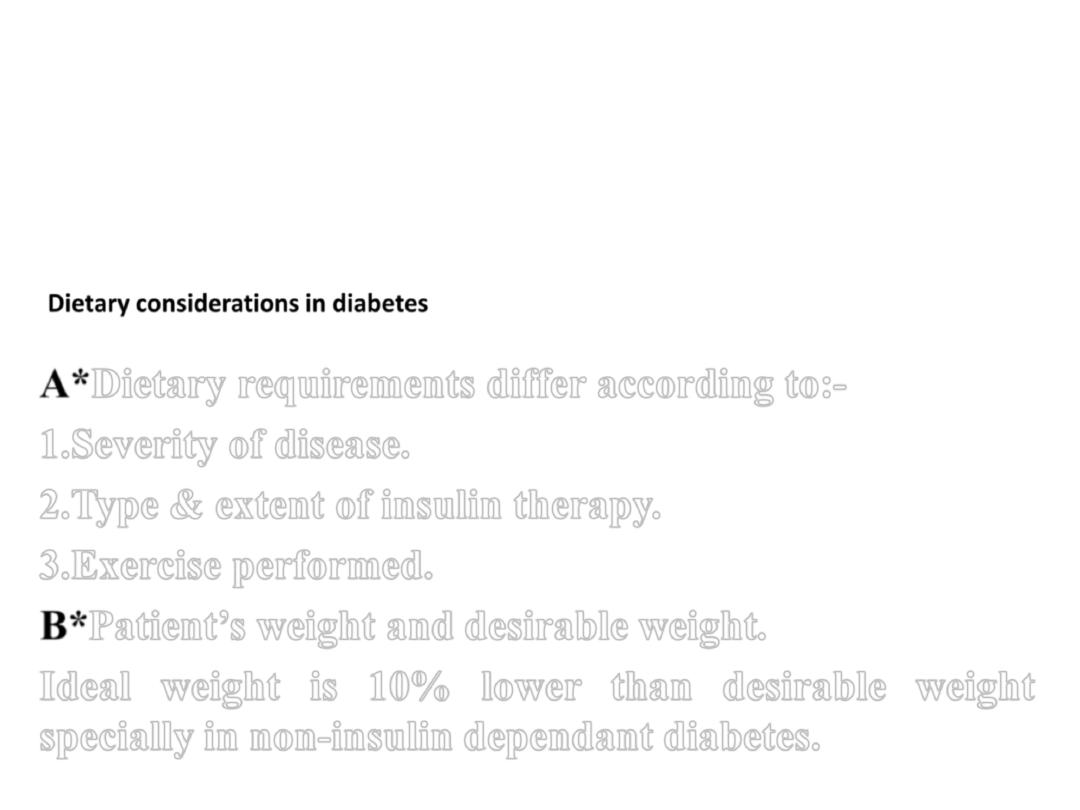
Nutritionally , it can be adequate in all nutrients based on menu
selection .Oral nutritional supplements may be helpful.
Dietary considerations in diabetes
Its texture can range from blenderized smooth food
to ground ,chopped or soft solids.
A*
Dietary requirements differ according to:-
1.Severity of disease.
2.Type & extent of insulin therapy.
3.Exercise performed.
B*
Patient’s weight and desirable weight.
Ideal weight is 10% lower than desirable weight
specially in non-insulin dependant diabetes.

C*
Patients require regular spacing of food intake to prevent
intermittent periods of hypoglycemia specially insulin dependant
diabetes.
Diet in GIT diseases:-
D*
Nutritional
requirements
are
greater
in
any
growing child or those patients who are physically
active persons.
I.Bland diet:-
It is that diet which has smooth and bland consistency
or texture .
It has a bland taste and considered chemically ,
physiologically and thermally non-irritating.
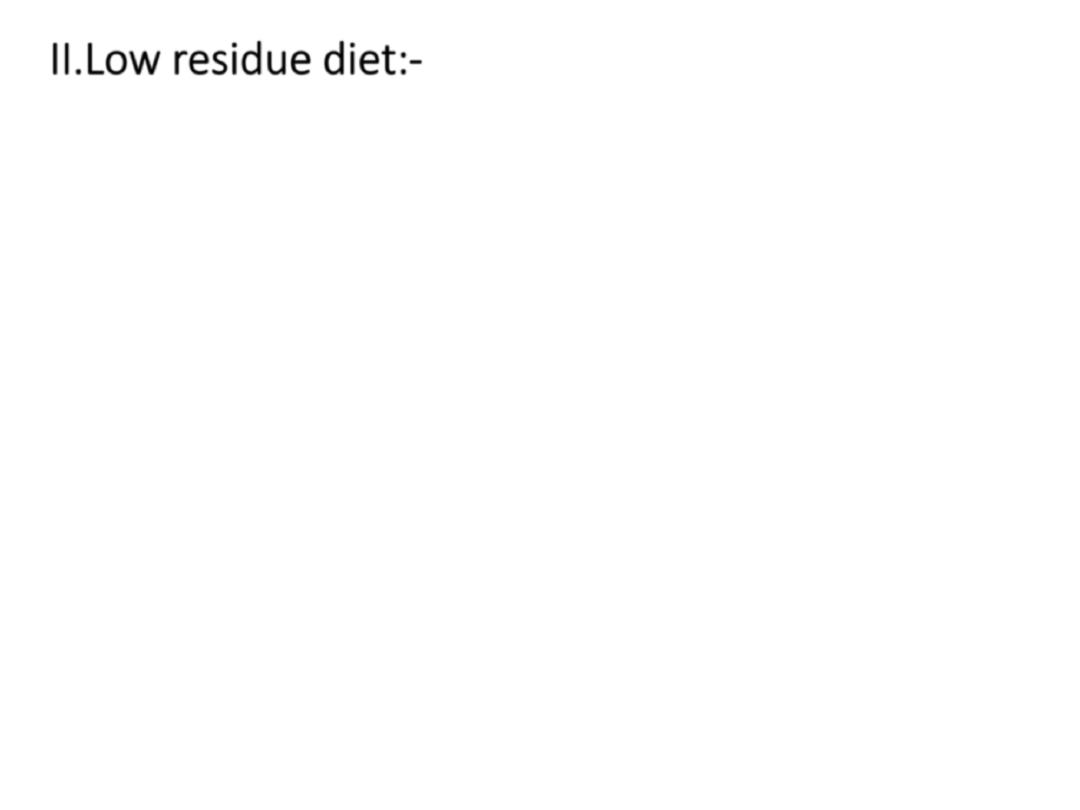
II.Low residue diet:-
It is that diet which leave a small or minimal amount
of residue in lower intestinal tract after digestion and
absorption have taken place proximally.
It is desirable in conditions where the bulk of fecal
material presents a strain , particularly after surgery
involving lower intestine.
It is used in preparation of patients for intestinal
surgery.
Also used to rehabilitate organ obstruction ,
distension , edema and inflamed bowel wall.
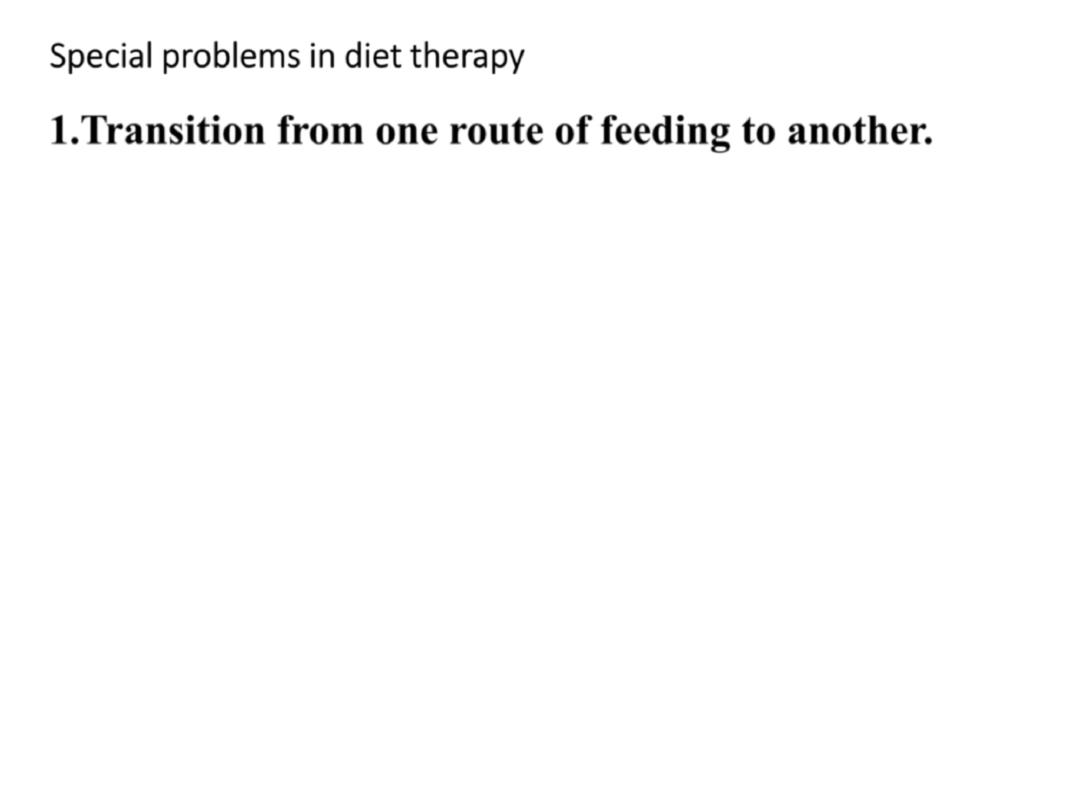
Special problems in diet therapy
Transitional feeding refers to the process of return to
the usual feeding pattern after total parenteral nutrition
, peripheral hyper alimentation or enteral feeding by
gastrostomy , jejunostomy , esophagostomy
or
nasogastric tube.
After extended periods of disuse , the gut may not
function normally and unless the transition process is
carefully monitored , oral intake and or food absorption
may be inadequate.
1.Transition from one route of feeding to another.
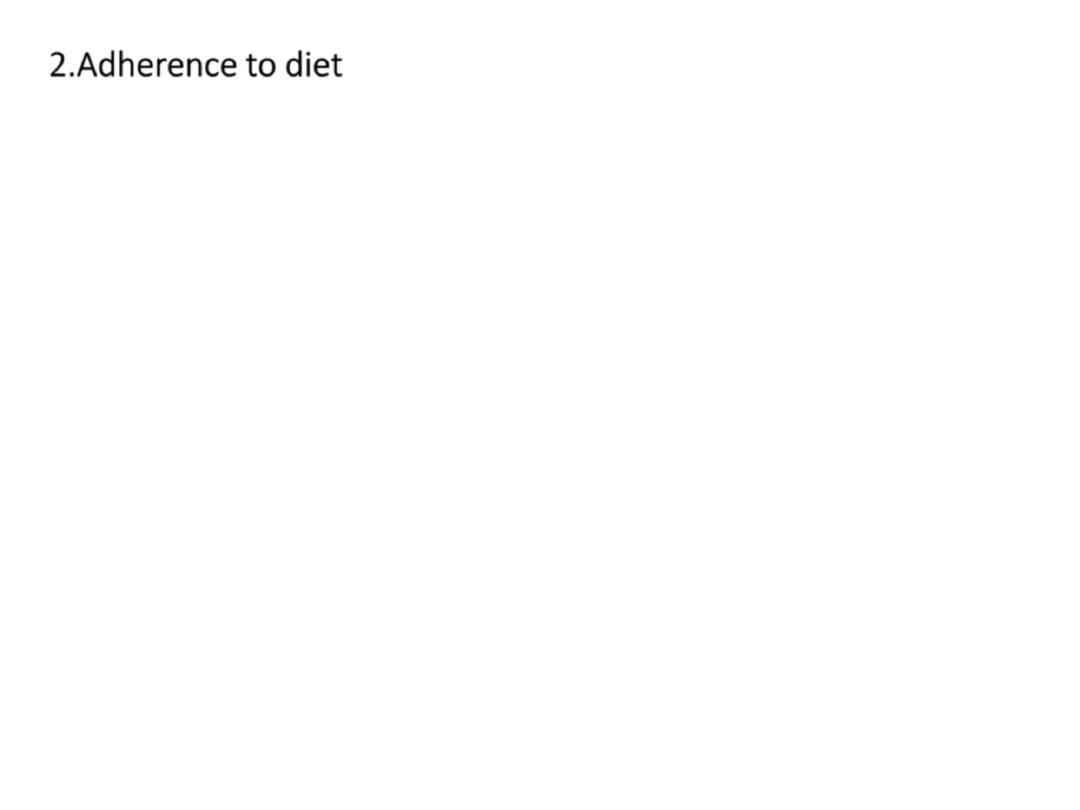
2.Adherence to diet
Compliance
with
therapeutic
dietary
recommendations is relatively easy to monitor in
hospitalized patients . However , patient may refuse or
be unable to eat or may miss meals because of
diagnostic tests . Therefore , nutritional status and
patient adherence should be monitored carefully even
in the hospital.
To implement therapeutic diets in outpatients ,
patient must be motivated and must understand the
diet instructions and the changes in what to be eaten.
New food buying , food preparation , and eating habits
may be required.
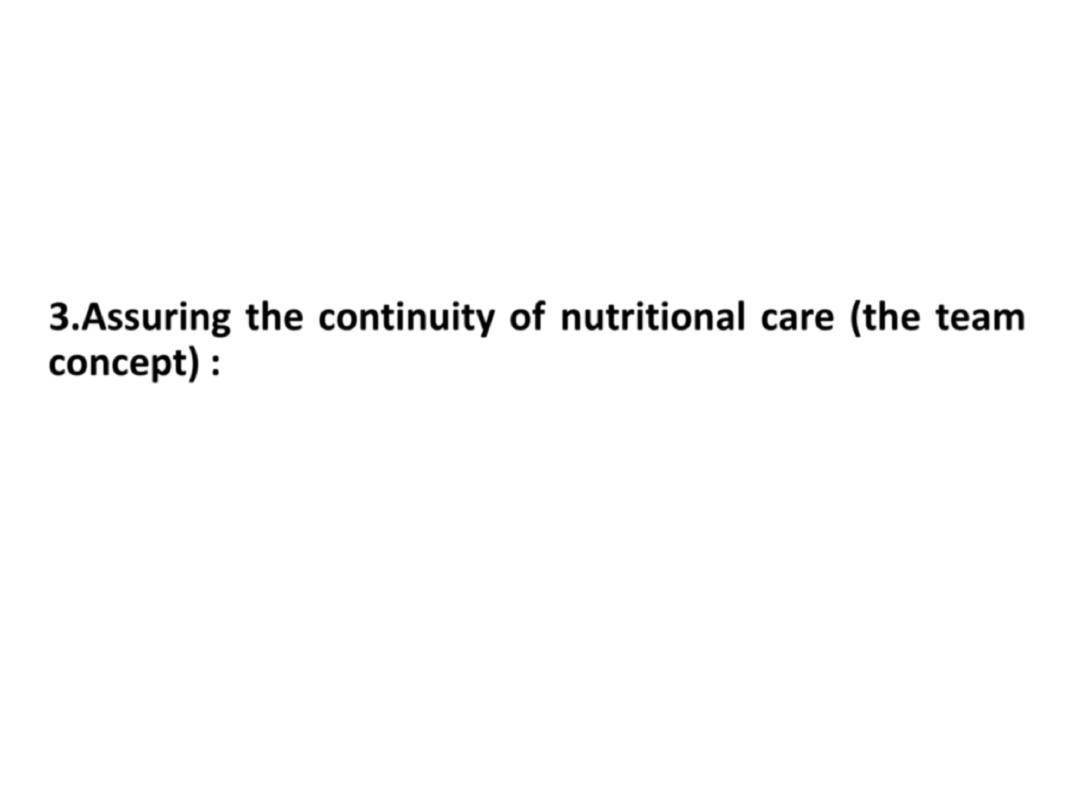
Psychological support ; assistance in learning new food
preparation buying and management skills ;help with
eating ,help in obtaining financial support to buy special
foods ;and general education about importance of diet are
as important as nutritional advice.
3.Assuring the continuity of nutritional care (the team
concept) :
Nutrition is too important to be the sole
responsibility of a single member of the health team.
Nutritional counseling can and does change dietary
habits and each health -care provider has a critical
role in assuring that nutrition is adequate . However :
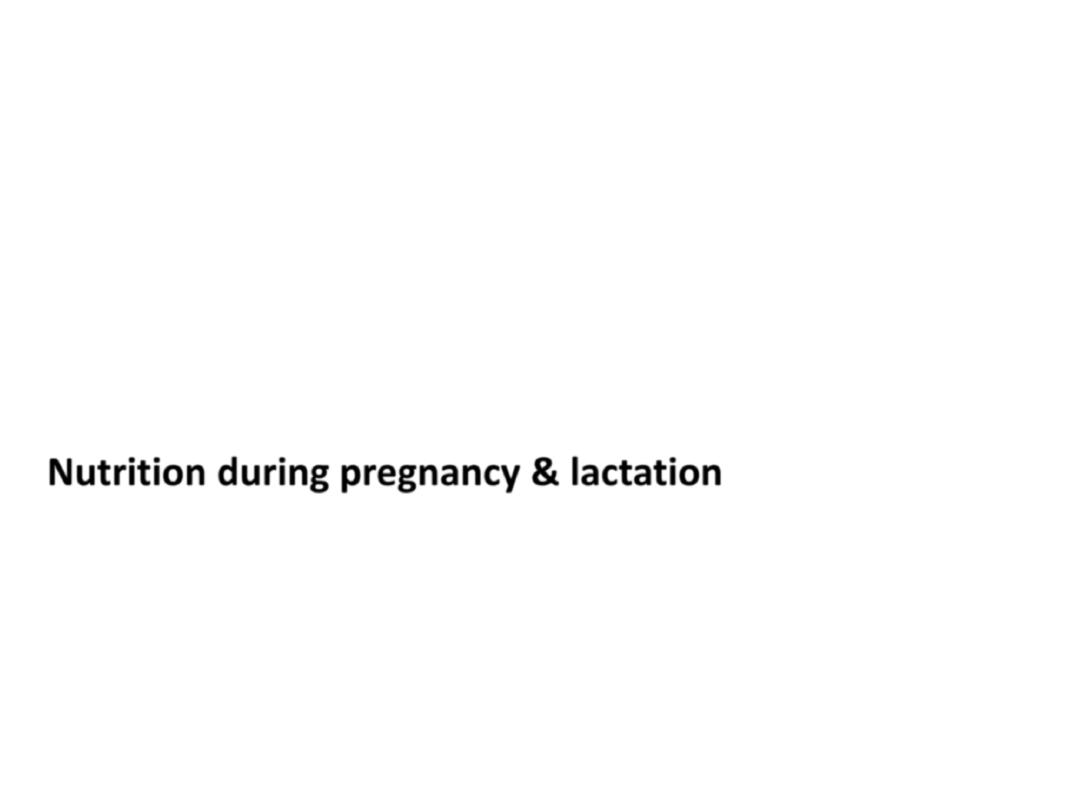
Physicians rarely obtain through diet histories , address
potential barriers to change in eating habits , or offer
special guidance on food selection.
Nutrition during pregnancy & lactation
The major role of physicians is to expand the content
of nutritional information they provide , to emphasize
the health benefits of good nutrition to refer those
requiring help to dietitians or other specialized
providers.
Maternal nutrition is critically important for both
mother and her child .
Several determining factors for maternal nutritional
requirements :-
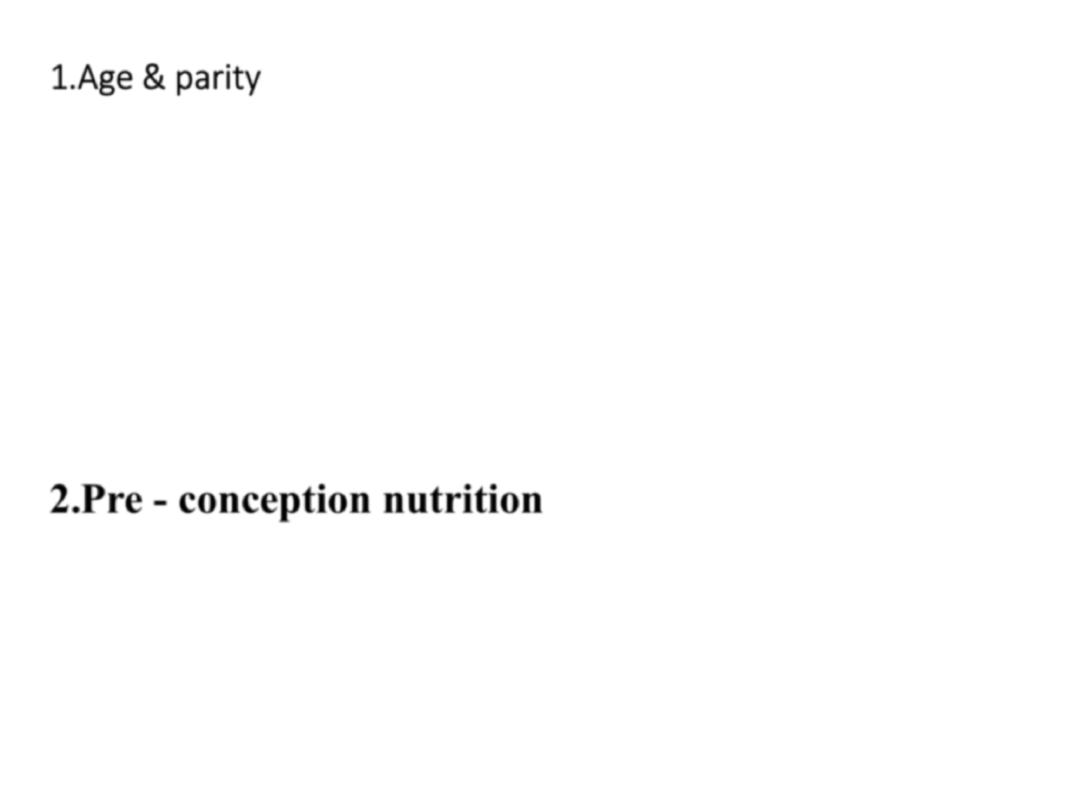
1.Age & parity
Maternal age to start with pregnancy is very
important e.g. A teenage pregnant need to add her own
growth needs to those imposed by her pregnancy state.
Multiparty also need more nutritional requirements.
2.Pre - conception nutrition
Maternal nutrition and health status before becoming
pregnant has an important impact upon pregnancy
outcome.

3.The complex metabolic interactions of gestation
During pregnancy , woman body , placenta and fetus
will form a unique biological unit with a constant
biological interactions and nutritional requirements.
4.Placenta work in a selective manner
۞Vitamin C concentration in fetal serum is usually 2-
4 times that of the mother.
۞Vitamin A serum level in mother is greater than in
fetus .
۞Placenta conserve much hemoglobin for fetal
construction at the expense of his mother.

5.Maternal weight
Underweight mother tend to add weight at the
beginning of pregnancy on the expense of her child or
fetus . Excessive weight gain can affect fetus and
process of delivery.
Nutritional requirements during pregnancy
۞During pregnancy , the caloric requirements must
be increased by 10-15% of the daily standard needs in
the pre-pregnancy period.
۞About 300-400 Kcal/day is the amount of additional
caloric requirements specially during the second and
third trimesters.
۞An
additional
20-30
gms
of
proteins
is
recommended throughout pregnancy.

۞Additional calcium need is about 0.4 gm daily.
Note :-
1.In regard to lactation , additional 40 gms of proteins
is needed daily.
2.Each 100 ml of breast milk require 130 Kacl as an
additional requirement.
۞
Daily additional iron requirements is 30-60 mg .
۞
A proportional increase in vitamins intake should be
done with the increased caloric requirements.

About 800 ml of milk is usually produced during 24
hours , thus about 1000 Kcal is the additional caloric
requirements for lactation.
۞It is essential to ask pregnant and lactating women to
properly utilize available food stuffs in the region .
۞During pregnancy , usually there is some discomfort
feeling after taking three main meals , thus it is better
to have 5-6 meals during pregnancy and even during
lactation .
۞In regard to protein source , it is better to advice
pregnant to have plant origin protein with a twice
weekly animal origin proteins for essential amino acids
supplement.
۞It is better to encourage breast feeding practices.
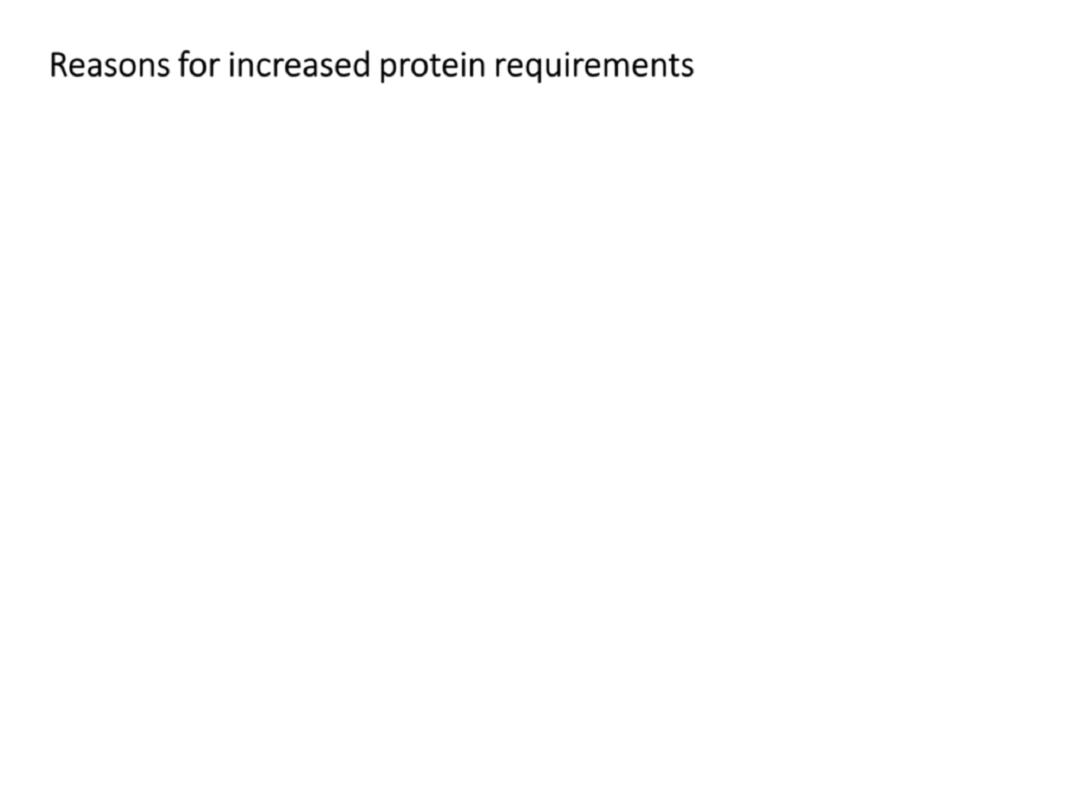
Reasons for increased protein requirements
1.Rapid growth of developing fetus.
2.Placenta development.
3.Maternal breast tissue increase.
4.Increased circulating blood volume by 20-50% .
5.Amniotic fluid formation.
6.Increased storage reserve by about 200-300gm of
nitrogen to be used for labour and during immediate
postpartum period.

The End
